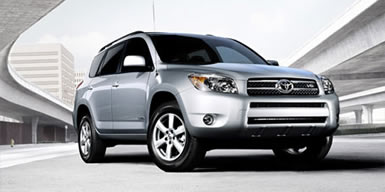
San Francisco: The
RAV-4 might be considered the grandfather of compact SUVs. It has been
around seemingly forever. The RAV-4 changed the way we collectively
think about SUVs, that they are not all big, hard-riding, gas-guzzling
behemoths. They could be smaller, car-like, fun, and fuel-efficient.
But even the
RAV-4 had to grow up. The trick ahead of Toyota was how to mature the
RAV-4 without losing its loyal following, and how to make it more
mainstream while keeping its “kick up your heels” attitude. I think
Toyota has done that very successfully.
The biggest
change to the RAV-4 is the inclusion of a V6 engine option. The
differences between the standard 4-cylinder and the V6 are both vast and
miniscule. The 4-cylinder, 2.4-liter, DOHC produces 166 hp and 165
lb.-ft. of torque, while the 3.5-liter, DOHC V6 ups that to 269 hp and
246 lb.-ft. of torque. That is a lot of difference. But at the same time
the V6 is rated at 22-mpg city and 29-mpg highway, while the 4-cylinder
is rated at 24 and 30 respectively for 2WD models. I am sure Toyota will
sell some 4-cylinder RAVs but for the life of me I am not sure why
anyone should buy one.
The 4-cylinder is
available only with a four-speed automatic transmission, and the V6 is
equipped only with a five-speed automatic. The days of manual
transmissions in family vehicles are limited. Front-wheel-drive is the
standard mode of power delivery; four-wheel-drive is
optional. Four-wheel disc brakes with ABS stop the RAV regardless of the
engine. The ABS is part of something Toyota calls the Star Safety
System, which also includes Vehicle Stability Control, Traction Control,
Electronic Brake-force Distribution and Brake Assist.
It has been over
ten years since the original RAV-4. Gone is the 3-door version, there is
only a 5-door RAV now. From my perspective this is the best looking RAV
of them all, well proportioned with a familial face. Entry into the RAV
is good from every door. A third row of seating is an available option
and entry to the very rear is probably best left to limber children. The
rear (middle seat) will accommodate three adults but for a trip of any
distance two will be more comfortable. The rear cargo door is hinged on
the right (passenger or curb) side, which is a problem because that
means it opens on the roadside. This might be appropriate in Japan but
not here.
I drove both a
4-cylinder and V6 versions and although I was completely satisfied with
the smaller engine I cannot see a reason, other than the cost, to go
with the 4-cylinder. The V6 is just such a nice engine. I would say the
only downside I felt was that the throttle response was a little
aggressive, meaning that it took a little practice to modulate it.
One big benefit
of the V6 is the towing capacity. The 4-cylinder is rated to tow 1,500
lbs., whereas the V6 with the towing package is rated for 3,500
lbs. That is quite an increase.
Another
difference is the tire size. The base 4-cylinder is equipped with
P215/70R16 all season tires with 17 inch tires optional. The V6 is
equipped with P225/65R17 all season tires with 18 inch tires optional.
There are three basic
RAV-4 models. They are the Base, Sport, and Limited. Prices start at
$20,850 for the Base 4-cylinder, 2-wheel drive, and climb to $27,065 for
a 4WD Limited V6. Fully optioned you can get the price over
$30,000. What do you get for that kind of money? The RAV-4 is a very
good compact SUV with Toyota’s bulletproof reputation. By
Bruce Hotchkiss © AutoWire.Net - San Francisco

Toyota Home Page
Byline:
Syndicated content provided by Tony Leopardo © AutoWire.Net
Column Name: The RAV-4 is a very good compact SUV
Topic: The 2006 Toyota RAV-4
Word Count: 676
Photo Caption: The 2006 Toyota
RAV-4
Photo Credits: Toyota Internet Media
Series #: 2006 - 62
Download
the Microsoft Word version here:
2006 Toyora RAV-4
Download the Original Image File here:
2006 Toyora RAV-4


|
